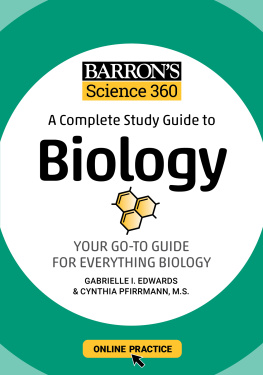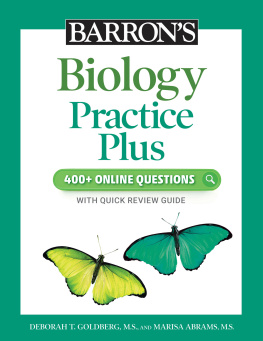Table of Contents
Guide
Page List


Copyright 2021 by Kaplan, Inc., d/b/a Barrons Educational Series
Copyright 2019 by Kaplan, Inc., d/b/a Barrons Educational Series under the title Barrons Biology: The Easy Way
Copyright 2009 by Kaplan, Inc., d/b/a Barrons Educational Series under the title E-Z Biology
Copyright 2000, 1990, 1984 by Kaplan, Inc., d/b/a Barrons Educational Series under the title Biology The Easy Way
All rights reserved.
No part of this publication may be reproduced or distributed in any form or by any means without the written permission of the copyright owner.
Published by Kaplan, Inc., d/b/a Barrons Educational Series
750 Third Avenue
New York, NY 10017
www.barronseduc.com
ISBN: 978-1-5062-8133-9
10 9 8 7 6 5 4 3 2 1
All rights reserved under International and Pan-American Copyright Conventions. By payment of the required fees, you have been granted the non-exclusive, non-transferable right to access and read the text of this eBook on screen. No part of this text may be reproduced, transmitted, downloaded, decompiled, reverse engineered, or stored in or introduced into any information storage and retrieval system, in any form or by any means, whether electronic or mechanical, now known or hereinafter invented, without the express written permission of the publisher.
CONTENTS
Barrons Science 360: Biology is designed for self-learners and for those looking for a comprehensive guide to everything biology.
This book includes a number of helpful tools that will reinforce your knowledge of the topics as you learn. Youll find:
What You Will Learn Each chapter begins with a list of the topics covered. This is a useful tool for categorizing the learning process and for devising a study plan.
Terms and Definitions Important terms are defined where necessary to help guide you through topics successfully.
Examples with Solutions Numerous examples for each topic are included throughout, along with answers to check your progress.
Review Exercises Each chapter closes with review questions that will help determine which topics you have a solid understanding of and which topics you need to revisit.
Online Practice Questions Access to 50 online multiple-choice questions designed to enhance your understanding and to test your knowledge. To access, see the card at the front of the book.
BARRONS 360 STUDY TIPS
SET GOALS AND OBJECTIVES
As you use Barrons Science 360: Biology, it is a good idea to set personal goals to chart and direct your learning objectives. A goal is something that you wish to achieve over a period of time. Objectives are short-term targets that help you reach a particular goal. For example, suppose that your goal is to learn all the bones in the human skeletal system so well, that if asked to name all the bones in the spine, you would be able to do so without thinking twice. You can reach this goal by establishing short-term objectivessuch as committing to study one body part per daythat will enable you to successfully reach your long-term goal of learning the entire skeletal system.
CUSTOMIZE YOUR STUDY
Barrons Science 360: Biology does not need to be studied in a linear fashion. If there is a particular topic that you want to study or reinforce, just turn to that page or chapter, and all the information along with the features mentioned above will be available to you. There are also some things you can do to optimize your study time and ensure you are retaining the important information you want to learn.
Before You Read
Review: Review all chapter headings and subheadings and the information in the What You Will Learn section.
Scan: Glance over any illustrations, tables, or graphs in the chapter youll be reading.
Locate Terms and Definitions: Read any bold or italicized words and study their definitions.
Get Ahead of Yourself: Review the Practice Exercises at the end of the chapter and keep them in mind as you study the chapter.
While You Read
Predict: Try to predict the answers to the questions in the Practice Exercises. This will help flag important information to keep an eye out for as you read.
Read Aloud: Hearing what is written on the page leads to better comprehension and retention of information.
Visualize: Developing a picture in your mind of the information, concepts, or material presented makes it much easier to remember.
Highlighting and Note-taking
Identify Important Facts: Dont over highlight. This will have the opposite effect and actually negatively impact your ability to retain the information you need to remember.
Take Notes: Jot down key ideas and concepts you are having a hard time understanding.
Draw It Out: Sketch out pictures, graphs, diagrams, or tables to help visualize what youre reading. This is particularly helpful with complex topics.
After You Read the Chapter
Talk It Out: Summarize what you have learned from the chapter aloud to a friend or a family member. Explain it as if they are learning it for the first time.
Answer the Questions in the Practice Exercises: Did you need to look them up, or were you able to answer them from memory?
Reinforce: If you found yourself having to look up the answers to the questions, go back and read those portions of the chapter again until you feel confident moving on to the next chapter.
Good luck!
WHAT YOU WILL LEARN
In this chapter, you will review how the science of biology began and how modern biologists gather information.
SECTIONS IN THIS CHAPTER
LEARNING ABOUT LIFE
Science investigates the forces that affect the Earth and its living creatures. Through observation and experimentation, scientists strive to solve the tricky puzzles that hide the causes of events that shape the world. The work of modern science has changed the world remarkably with new and important discoveries in areas such as communication, travel, agriculture, and medicine. How scientists do their work will be discussed in this chapter and in chapters to follow. Biology is the science that studies life and living things, including the laws that govern the events of life.
Every type of life from the smallest microscopic living particle to the largest and most imposing plant and animal species is included in the study of biology. Biological study covers all that is known about any plant, animal, microbe, or other living thing of the past or present.
As defined above, biology is the science of life and living things. Biology is a natural science. It is the study of individual life forms within the world of life known as nature. It is the science of fishes and fireflies, grasses and grasshoppers, humans and mushrooms, flowers and sea stars, worms and molds. It is the study of life on top of the highest mountain and at the bottom of the deepest sea.
















